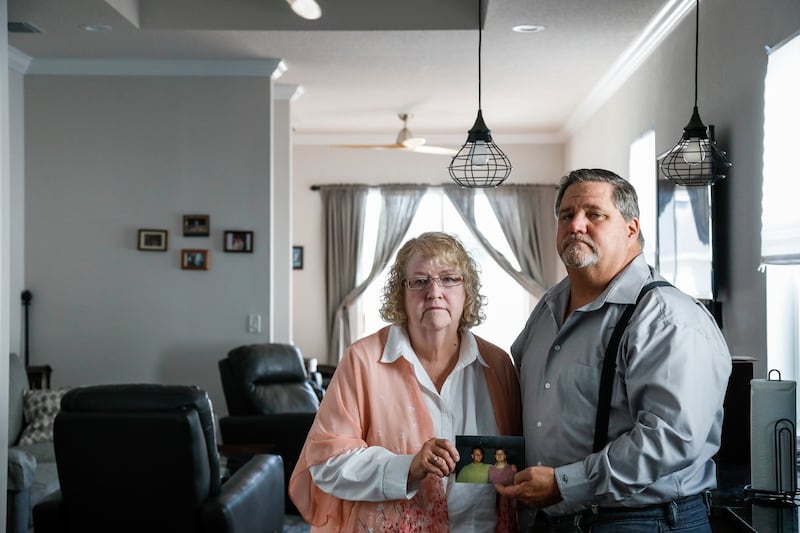A neighbour walking his dog in the East Village in Manhattan saw the man one night, sitting motionless behind the wheel inside a parked car. Two days later he was still there. The windows were up, the engine off – this during an August heatwave. The neighbour called 911.
Soon the block of East 12th Street was busy with police officers and their bosses, the car roped off with yellow tape. There were no signs of foul play. A team from the chief medical examiner’s office arrived that afternoon of August 31st and removed the body to determine the cause of death. People who lived and worked nearby kept their distance.
None of the initial police findings would prove true. Not the cause of death. Not the man's name. And not the length of time the dead man's body spent in the car
The police later released the man's name – he was Geoffrey Corbis, aged 61, of Bridgeport, Connecticut – and said he appeared to have died of natural causes about two days before he was found there. None of those initial findings would prove true. Not the cause of death. Not his name. And not the length of time the dead man's body spent in the car. It was far longer than two days. It is now believed the dead man was there for a full week – a week that his family spent in vain asking the police to look for him.
The chain of events serves as a stark reminder that even in 2018 New York, a city that lives beneath the nonstop gaze of countless surveillance cameras, one that for years has urged its citizens, if they see something suspicious, to say something, it is still possible for a dead man in a parked car on a busy block to go unnoticed for days.
The events leading up to and following that August day also unspool a story about a distressed man’s plan to raise some fast cash, thwarted by circumstance, and his grim resolve in his final hours to end his life, detailed in farewell text messages to his loved ones.
GEOFFREY CORBIS was an alias he created in desperation in recent years. Before then he was Geoffrey Weglarz, born in 1957, one of seven children raised in Florida. He grew up to embrace acting as a passion, performing in local plays and musicals with an intense energy.
"He seemed hardly able to get the words out as fast as the synapses fired," Sal Biagini, a friend and fellow actor in the busy dinner-theatre circuit of the late 1970s, says. "He had impeccable timing." Weglarz had come of age during the Apollo missions to the moon, and he and Biagini would spend hours rehashing the details of each expedition. Weglarz channelled his leanings towards science and technology into a career in computer programming.
He moved to New York City and worked at the software company Hyperion, designing performance-management tools. He led a team at Hyperion that worked with universities, signing and managing Yale, Harvard, Brown and dozens of other schools as clients. He travelled the world.
He married and had a son, settling down in a large, 19th-century house in Fairfield, Connecticut. His friend Biagini, himself having found success as a longtime body double for Robin Williams, visited and marvelled at how far his fast-talking fellow space geek had come.
“It was Geoff having come to fruition as a responsible, high-earning family man,” he says. “He adored his son. He adored his wife. He had it all.” Then he lost it all. Hyperion was acquired by Oracle in 2007, and eventually Weglarz was offered a new position in the company, one that he viewed as a lateral move at best, Biagini says. He left and went to Dell as a senior director of development. He and his wife divorced. They shared custody of their son. The job at Dell required weekly trips to the company’s headquarters in Texas, which proved a burden, and he left the job in 2011.
His search for the next job was exhausting and fruitless. In 2013, when the PBS programme NewsHour visited Connecticut to do a story on older, unemployed Americans, the episode centred around an interview with Weglarz. "I've applied for 481 jobs," he said on the show. "None of them have panned out. They think that anybody over a certain age is going to be used up." He was nearing the bottom financially.
“I’ve gone through my savings. I’ve gone through my 401(k) [pension fund]. My unemployment last cheque is next week. I have about $2,000 to my name, and after that I don’t know.” His son was 14 and came home from school every day with friends in tow. Weglarz said it was nice to spend that time with him but he wished the friends’ parents would chip in for the snacks they ate.

SOMETHING ELSE HAPPENED that year, a split-second outburst that would change his life. On March 26th, 2013, Weglarz entered the drive-through lane at a McDonald's and picked up a sandwich. He drove away but returned and complained that he had been given the wrong order. He threw the sandwich at a woman employee in the drive-through window. Press accounts of the incident – many news outlets were drawn to the quirky circumstances – reported that she was pregnant.
The police were called. He was charged with disorderly conduct, and although that charge was later dropped, the news stories would follow Weglarz. They appeared on top of any online search of his name – this as he was looking for work. So he changed his name to Geoffrey Corbis. He stuck with acting, mainly in Connecticut community theatre, cast as recently as last year in a production of the Pulitzer Prize-winning August: Osage County staged in a church. His brother, Larry Weglarz, and one of his sisters, Pamela Lindemann, were living in Florida, and he travelled there for a long visit.
Then, late last spring, a bit of good news: he was contacted by a group trying to start a nonprofit executive-coaching business. Geoffrey Corbis would be named its chief technology officer; his biography page on the company site included his portrait, but in reality there was no full-time job or salary yet.
In July or August, Geoffrey Weglarz told his sister he had obtained a vial of poison used for euthanasia. 'That way, when I'm ready, I can go painlessly and fast'
He returned north, to Washington, DC, for a small project for the consulting business in May, shooting a video that earned him $2,000, his sister says. His mood, in hindsight, was darkening. In July or August, Geoffrey Weglarz – still the name most everyone knew him by – told his sister that he had obtained a vial of poison used for euthanasia. He had bought it on the dark web, she says he told her. “That way, when I’m ready, I can go painlessly and fast,” he told her.
As shocking as that would seem for someone to hear, that kind of talk was not out of character for Weglarz, his sister says. He was prone to morbid talk. “To me it’s, like, ‘Well, at least he didn’t get a gun,’ ” Lindemann says. “I didn’t know really what to say to him. I was surprised.” She remembers asking him, “ ‘What are you going to do with this?’ ” “ ‘I’m just going to carry it around with me,’ ” he told her. “He was very rational. Very resolved.”
ON AUGUST 24TH, what is believed to be the last day of Weglarz's life, licence-plate readers recorded his vehicle entering Manhattan at 1.18pm, the police would later tell his brother, Larry Weglarz. He seemed to have travelled straight to B&H Photo Video, an electronics store in midtown, where he sold a camera tripod to the store for $275. He had recently told his family he was broke. It was 2.04pm, store records show.
He next arrived at a Wells Fargo Bank, where he attempted to cash the cheque. But it is standard procedure for banks to call B&H to confirm a cheque is legitimate before cashing one, and by that time on a Friday the store had closed, and no one answered the phone. Geoffrey Weglarz left the bank empty-handed. And distraught.
Later that afternoon Weglarz’s old friend Biagini texted him. No real reason; they hadn’t spoken in months. “Hey Geoffrey, checkin’ in with you,” Biagini wrote. “How goes it?” “Actually down in Lower Manhattan right now,” Weglarz replied, and added: “Finishing things up.” “Sounds ominous,” Biagini replied. “I am honored to have been your friend,” Weglarz wrote, “Take care.”
At 5.42pm Weglarz sent his sister a final text, one that immediately reminded her of his obtaining poison weeks earlier. It read, “Stuff does taste as bad as I thought it would.”

WORRIED AFTER THE TEXTS, Biagini called 911. The police tracked Weglarz's phone to the closest address, 520 East 12th Street. Officers arrived at the building and went inside. They saw no sign of him and left. They did not realise he was parked in front of a playground next to the address, 15 car lengths from the building's entrance.
The next day, a Saturday, Biagini visited a police station to report Weglarz’s suicidal texts. The police asked if Weglarz was a city resident, and when he said no the officers said “We can’t help you,” he says. In Florida, Lindemann and Larry Weglarz, a retired police officer himself, called the ninth precinct, which covers East 12th Street, asking for help. “I begged and explained since he was likely dead at this point, we would be relieved if he was found before he started to decompose,” Larry Weglarz says. “I explained he was likely in his car, dying or dead.”
He, too, was told of the policy about city residents, he says. A police spokesman says officers routinely assist outside law-enforcement agencies that report a missing person in New York City, but those cases begin with someone filing a report with the police from where the person lived. On Monday, three days after Geoffrey Weglarz sent his final texts, his siblings filed a missing-person report with the local sheriff in Tampa. That office attempted to fax a report to the police in New York, Larry Weglarz says. The New York police said the report needed to be resent by email, and more days passed.
Larry Weglarz told the police that his brother also went by the last name Corbis, and with that, officers discovered his licence-plate number. They found a licence-plate reader that recorded the vehicle entering Manhattan that Friday afternoon, but nothing since. Officers also contacted hospitals without success.
The week dragged on in the grip of a heatwave, with neighbours oblivious to the body. One mother who lived on the block said later in an interview that her young son had complained of a smell that she herself didn’t detect. He had thrown up on the pavement.
A couple of people visiting a nearby garden complained to a manager about what smelled like a dead rat. The manager actually found one, and disposed of it, but the smell lingered
Raymond Russell, an estate agent with an office across the street, says he parked his motorcycle in front of the vehicle that week and would have looked right past the dead man towards oncoming cars before crossing. He finds it impossible to believe the body was there as long as it was. “I don’t give him a week here,” he says. “A couple days, maybe.”
Traffic officers who write parking tickets most likely passed by him at least twice, on days that his car was parked illegally. Officers looking for violators on street-cleaning days – on East 12th Street those days were Tuesday and Friday – routinely ignore vehicles when the driver is sitting inside. Geoffrey Weglarz’s vehicle received no tickets on the Tuesday or Friday when it was parked illegally, suggesting an officer might have seen him and assumed he was just another idle driver.
A couple of people visiting the garden on the corner and its neighbouring playground complained to a garden manager about what smelled like a dead rat. The manager actually found a dead rat and disposed of it, but the smell lingered on and off.
In the middle of the week Anthony Greenheck, walking his dog late one night, noticed a silhouette of a man behind the wheel. He thought it was an Uber driver napping between calls. But when he saw the man had not moved two days later, he approached. The windows were tinted.
“I peeked a little closer and I decided to knock,” Greenheck says. “No movement.” He called 911. When firefighters and the police arrived and opened the vehicle’s door, a powerful odour filled the block for hours. Officers raised a curtain around the vehicle, obscuring the body inside as it was removed. A freelance photographer who lives across the street, Bob Krasner, went to his window and took pictures of the scene. “I must have walked by that car at least a half a dozen times while he was there,” he says in disbelief. “I’m fairly observant.”
THE EPISODE LEFT Geoffrey Weglarz's family furious with the police. They don't believe the chances were high that their brother could have been rescued after ingesting the poison, but they said he should not have been left there for a week. "It's supposed to be 'Protect and Serve'," Lindemann says. "Never in my wildest dreams would I have thought I couldn't depend on a police department for help."
The police spokesman, J Peter Donald, says officers did what they could with the information they had, including canvassing city hospitals. “Unfortunately, those efforts did not locate Mr Corbis,” he says.
Weglarz was cremated in September. His sister plans to scatter his ashes in Manhattan, home to many successes in his acting years and where he began his computer career, long before the day he parked his car on the street and never left. – New York Times











